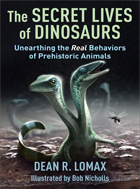Family Tree:
Dinosauria
Ornithischia
Genasauria
Neornithischia
Cerapoda
Marginocephalia
Pachycephalosauria
Dinosauria
Ornithischia
Genasauria
Neornithischia
Cerapoda
Marginocephalia
Pachycephalosauria
Pronunciation: pak-ee-SEF-a-lo-SOR-ee-uh
Meaning: Thick-headed lizards (See etymology)
Authors: Maryanska and Osmólska
Year: 1974
Locomotion: Bipedal (two legs)
Synonyms: Homalocephalidae (Dong, 1978)
Meaning: Thick-headed lizards (See etymology)
Authors: Maryanska and Osmólska
Year: 1974
Locomotion: Bipedal (two legs)
Synonyms: Homalocephalidae (Dong, 1978)
[Sereno, 2005]Definition
The most inclusive clade containing Pachycephalosaurus wyomingensis but not Triceratops horridus, Hypsilophodon foxii, Heterodontosaurus tucki, Ankylosaurus magniventris.
About
Pachycephalosaurs, also known colloquially as "bone heads", were small to medium-sized herbivores that lived during the Mid to Late Cretaceous, and have been the cause of much head-banging between palaeontologists for decades because of one seemingly unanswerable question: "were they head-bangers or not?"
Some researchers insist that the domed skulls of pachycephalosaurs, which in some cases are six inches thick, were made from brittle bone, and those with particularly high and curved domes would require the precision of a surgeon to pull off anything more than a glancing blow. Also, despite being quite stocky and well-made, their head, neck and spine could not be aligned in such a way to transmit stress, unlike modern-day Musk Ox. So perhaps, instead, they participated in bouts of flank butting which would inflict pain aplenty on whatever was on the receiving end, especially when you consider the lumps and horns that adorn some domes.
The opposition researchers, well, they are all for head-banging. As well as a unique "wall" of bone on the inside of the eye socket to perhaps secure the eyeball and protect it from contact shock during ramming contests, around 22% of 100 pachycephalosaur skulls that were scrutinized as part of a 2013 study sported damage that had previously been brushed off as artefacts of preservation, but which were consistent with osteomyelitis; an infection of the bone as a direct result of penetrative trauma, or trauma to the surrrounding tissue which led to bone infection. Unless consistent external factors were at work, it seems likely that these surface wounds, which had healed as well as could be, were incurred during bouts of head-to-head combat. Flat-headed specimens, which may well be juveniles rather than distinct adult species, were damage free.
Of course, whether pachycephalosaurs were headbangers or not, we'll never know for sure. But we're willing to bet that males with the biggest domes were more popular with females than those with smaller ones.
Click here to search Dinochecker for pachycephalosaurs.
Etymology
Pachycephalosauria is derived from the Greek "pakhys" (thick), "kephale" (head) and "sauros" (lizard), and the Latin "-ia" (plural-forming suffix).
Relationships
References
• Maryanska T and Osmólska H (1974) "Pachycephalosauria, a new suborder of ornithischian dinosaurs". Palaeontologica Polonica, 30: 45–102.
• Maryanska T, Chapman RE and Weishampel DB (2004) "Pachycephalosauria". Page 464–477 in Weishampel, Dodson and Osmólska (eds.) "The Dinosauria: Second Edition".
• Snively E and Cox A (2008) "Structural mechanics of pachycephalosaur crania permitted head-butting behavior". Palaeontologia Electronica, 11 (1).
• Paul GS (2010) "The Princeton Field Guide to Dinosaurs".
• Brett-Surman, Holtz and Farlow (2012) "The Complete Dinosaur: Second Edition".
• Peterson JE, Dischler C, Longrich NR (2013) "Distributions of Cranial Pathologies Provide Evidence for Head-Butting in Dome-Headed Dinosaurs (Pachycephalosauridae)". PLoS ONE 8(7): e68620. DOI: 10.1371/journal.pone.0068620















